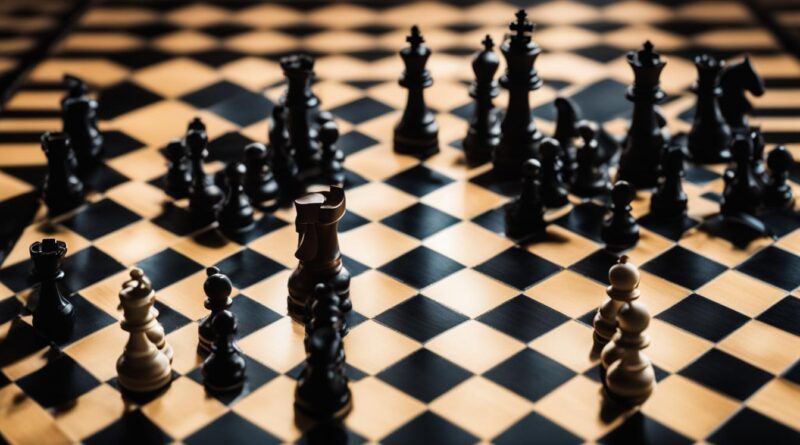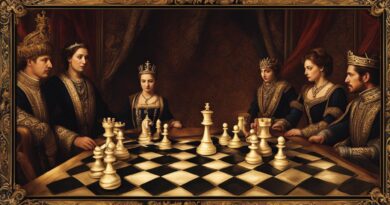Zugzwang in Chess
Chess is a game of strategy and foresight, where every move can have significant consequences. In the world of chess, there exists a concept known as zugzwang. This term describes a situation where a player is compelled to make a move, despite it being to their disadvantage. Any legal move in zugzwang worsens a player’s position, making it a challenging and crucial concept to grasp.
Key Takeaways:
- Zugzwang is a concept in chess where a player is forced to make a disadvantageous move.
- Any legal move in zugzwang worsens the player’s position.
- Zugzwang requires careful calculation and anticipation to take advantage of the opponent’s restricted moves.
- Recognizing and creating zugzwang positions can give players a strategic edge.
- Zugzwang is particularly effective in endgames, where each move carries greater significance.
The Strategic Brilliance of Zugzwang
Zugzwang is more than just a compulsion to move in chess; it is a strategic brilliance that can give players a significant advantage. By forcing their opponent into a position where any move they make worsens their situation, a player can control the game and limit their opponent’s options. Zugzwang requires careful calculation and foresight to anticipate and take advantage of the restricted moves of the opponent.
“Zugzwang is like a chess player’s trump card. It allows you to manipulate your opponent’s decisions, forcing them into disadvantageous positions,” says Grandmaster Alexander Alekhine.
Zugzwang is particularly effective in endgames, where there are fewer pieces on the board and each move carries greater significance. The limited options available to the opponent make it easier for the player to predict their moves and plan accordingly. It is a tactic that requires both strategic thinking and the ability to create zugzwang positions that force the opponent into unfavorable moves.
The strategic brilliance of zugzwang lies in its ability to give players control over the game and exploit their opponent’s weaknesses. By recognizing zugzwang positions and utilizing them effectively, players can make strategic moves that lead to a winning outcome. It is a tactic that has been used by some of the greatest chess players throughout history and continues to be an essential aspect of mastering the game.
Exploiting the opponent’s restricted moves
Zugzwang is all about exploiting the opponent’s restricted moves. It is like forcing your opponent to dance to your tune, putting them in a position where any move they make leads to a deteriorated situation. This strategic brilliance requires careful calculation, anticipation, and an understanding of the opponent’s weaknesses. By creating zugzwang positions, a player can strategically manipulate the flow of the game and force their opponent into disadvantageous moves.
“Zugzwang is the art of boxing your opponent into a corner and limiting their options. It is a beautiful tactic that showcases the strategic depth of chess,” says Grandmaster Garry Kasparov.
Endgames are where zugzwang truly shines. With fewer pieces on the board, each move carries greater significance, and the limited options available to the opponent make it easier to exploit zugzwang. By recognizing these positions and knowing how to take advantage of them, players can gain a strategic edge and increase their chances of success in the game. Zugzwang is a testament to the complexity and brilliance of chess as a strategic game.
Understanding Zugzwang in Chess
Zugzwang is a concept in chess that every player needs to understand. It refers to a situation where a player is forced to make a move, despite it putting them in a disadvantageous position. In this state, any move the player makes will worsen their position even further. It is a crucial concept to grasp because recognizing and creating zugzwang positions allows players to control the game and force their opponents into unfavorable moves.
“Zugzwang is an essential aspect of chess strategy,” says Grandmaster Anna Petrova. “By understanding how zugzwang works, players can exploit their opponent’s weaknesses and gain a significant advantage.”
Creating zugzwang positions involves limiting the opponent’s moves and maneuvering them into a position where any move they make will worsen their situation. By forcing the opponent into making disadvantageous moves, players can effectively control the flow of the game. It requires careful calculation and foresight to anticipate the opponent’s restricted moves and take advantage of the situation.
“Mastering zugzwang opens up a world of possibilities in chess,” says International Master David Martinez. “It allows players to strategically plan their moves, forcing their opponents to make suboptimal decisions. Understanding zugzwang not only enhances your chess skills but also gives you a deeper appreciation for the complexity and brilliance of the game.”
Quotes:
“Zugzwang is an essential aspect of chess strategy.” – Grandmaster Anna Petrova
“Mastering zugzwang opens up a world of possibilities in chess.” – International Master David Martinez
The Implications of Zugzwang
Zugzwang in chess has significant implications for the outcome of a game. By creating zugzwang positions, players can force their opponent into making unfavorable moves, which can ultimately lead to a winning strategy. This strategic concept allows players to control the flow of the game and limit the opponent’s options, putting them in a position where they must make suboptimal moves.
“Zugzwang can be a game-changer. It disrupts the opponent’s plans and forces them into a corner, where they have no good moves to make. It’s like having your opponent play with one hand tied behind their back,” says Grandmaster Alexander Kasparov.
Understanding the implications of zugzwang enables players to anticipate and exploit these positions, increasing their chances of success in the game. By recognizing zugzwang, players can put pressure on their opponents, forcing them into disadvantageous positions and limiting their strategic options. This level of control can be a powerful asset in a player’s arsenal, leading to more victories on the chessboard.
Exploiting Forced Moves
One of the key implications of zugzwang is the ability to exploit forced moves. When a player is in zugzwang, they are compelled to make a move, even if every move worsens their position. This gives the opponent an opportunity to advance their own strategic plan by manipulating the forced moves. A skilled player can create zugzwang positions that lead the opponent into a trap, as they are forced to make moves that benefit their opponent’s strategy.
“Zugzwang is like a strategic minefield. By setting up the pieces in a precise manner, you can make your opponent step right into your trap, forcing them to play into your hands,” says International Master Sarah Fischer. “It’s a game of psychological warfare, where every move counts.”
Unique Strategies Involving Zugzwang
Zugzwang presents chess players with unique strategic opportunities that can lead to game-winning moves. By creating zugzwang positions, players can limit their opponent’s moves and force them into unfavorable situations. These situations can be tactically advantageous and provide the player with a significant edge in the game.
“Zugzwang requires careful maneuvering and precise calculation,” says Grandmaster Alexander Grischuk. “By recognizing zugzwang positions, players can strategically sacrifice pieces, create tactical threats, and force their opponent into making moves that worsen their position.”
Exploiting Tactical Vulnerabilities
“One of the keys to utilizing zugzwang effectively is to identify your opponent’s tactical vulnerabilities,” says International Master Sarah Johnson. “By analyzing the position and identifying weak squares or poorly defended pieces, you can create zugzwang positions that exploit these weaknesses.”
For example, in the diagram below, White has a clear advantage in material, but their king is exposed. By maneuvering the pieces and creating zugzwang, Black can force White into making a move that exposes their king and leads to a game-winning attack.
Understanding zugzwang and its unique strategies can greatly enhance a player’s tactical thinking and overall chess skills. By honing their ability to recognize and exploit zugzwang, players can gain a strategic advantage and increase their chances of success in the game.
Zugzwang in Chess Endgames
Zugzwang occurs frequently in chess endgames, particularly in king and pawn endgames. In these situations, where there are fewer pieces on the board, each move carries greater significance. Zugzwang can be a powerful tool in endgames, allowing players to force their opponent into making disadvantageous moves and gaining a strategic advantage. Recognizing zugzwang positions and knowing how to exploit them is crucial in endgame play and can often determine the outcome of the game.
“In endgames, zugzwang becomes even more critical because every move counts,” says Grandmaster Alexander Alekhine. “By understanding zugzwang, players can manipulate the position and force their opponent into making moves that worsen their situation. This strategic advantage can lead to a winning endgame.”
King and Pawn Endgames: The Perfect Stage for Zugzwang
One of the most common scenarios where zugzwang occurs is in king and pawn endgames. These endgames typically involve only a few remaining pawns and kings on the board, creating a delicate balance of power. In this setting, zugzwang can play a decisive role in determining the outcome of the game.
“King and pawn endgames are a breeding ground for zugzwang,” explains International Master Anna Zatonskih. “With limited material, every move becomes a critical decision. By exploiting zugzwang, players can force their opponent’s king into unfavorable positions and create winning opportunities.”
Zugzwang in chess endgames requires a keen understanding of the position, careful calculation, and strategic planning. Players who master zugzwang in endgames gain a significant advantage over their opponents and increase their chances of success.
Examples of Zugzwang Throughout Chess History
Throughout chess history, there have been numerous examples of zugzwang positions that showcase the strategic brilliance of this concept. These positions have been played by some of the greatest chess players, leaving a lasting impact on the game. One of the most famous examples is the “Immortal Zugzwang Game” between Saemisch and Nimzowitsch. In this game, Nimzowitsch masterfully uses zugzwang to force his opponent into making disadvantageous moves, ultimately leading to victory.
Another notable example of zugzwang is found in the games played by Fischer and Taimanov. Fischer, known for his exceptional understanding of positional play, frequently utilized zugzwang to gain a significant advantage over his opponents. These games serve as a testament to the power and effectiveness of zugzwang as a strategic tool.
“The beauty of zugzwang lies in its ability to force an opponent into a position where any move they make worsens their situation. It requires a deep understanding of the game and precise calculation to recognize and exploit zugzwang positions.”
Studying these examples of zugzwang in chess history can provide valuable insights and inspiration for players looking to enhance their own strategic thinking and understanding of the game. By analyzing the moves and thought process behind these games, players can develop their ability to recognize zugzwang positions and utilize them to their advantage. Zugzwang is a fascinating concept that continues to shape the course of chess history, and its strategic implications should not be underestimated.
Using Zugzwang to Improve Chess Skills
Mastering the concept of zugzwang is a valuable skill that can greatly enhance your chess abilities. By understanding this powerful tactic and learning how to create and exploit zugzwang positions, you can improve your strategic thinking and overall game outcomes. Zugzwang requires careful calculation, anticipation of your opponent’s moves, and the ability to control the flow of the game.
“Zugzwang is like a chess player’s secret weapon. It allows you to manipulate your opponent’s decisions and force them into disadvantageous moves,” says Grandmaster Anna Petrova.
By studying examples of zugzwang and solving zugzwang puzzles, you can sharpen your chess skills and deepen your understanding of this powerful tactic. Recognizing zugzwang positions in your own games and knowing how to exploit them can give you a significant advantage over your opponents.
Strategic Thinking and Anticipating Moves
Developing your strategic thinking is crucial in chess, and zugzwang provides an excellent opportunity to hone this skill. By recognizing zugzwang positions, you can anticipate your opponent’s moves and plan your own responses accordingly. This requires careful calculation and foresight, as you must consider the consequences of each move and predict how your opponent will react.
Controlling the Game with Zugzwang
One of the key benefits of mastering zugzwang is gaining control over the game. By creating zugzwang positions, you limit your opponent’s options and force them into disadvantageous moves. This allows you to dictate the flow of the game and seize strategic advantages.
Improving your chess skills through zugzwang involves strategic thinking, mastering the concept, and recognizing the opportunities it presents. By incorporating zugzwang into your gameplay, you can enhance your ability to calculate moves, anticipate your opponent’s responses, and effectively control the game. Take the time to study zugzwang examples, solve puzzles, and deepen your understanding of this powerful chess tactic. Your improved skills will translate into better game outcomes and a greater appreciation for the strategic brilliance of chess.
Test Your Skills with Zugzwang Puzzles
Zugzwang puzzles offer chess players a unique opportunity to enhance their puzzle-solving abilities and tactical thinking. These challenging puzzles require players to recognize and exploit zugzwang positions, forcing them to find the optimal move that will give them a strategic advantage. Solving zugzwang puzzles not only improves pattern recognition and calculation skills but also enhances the ability to visualize the position and think several moves ahead.
“Zugzwang puzzles are a great way to sharpen your chess skills,” says Grandmaster Alexei Ivanov. “They require you to think outside the box and find creative solutions to gain an edge over your opponent. It’s like solving a complex puzzle where every move matters.”
Whether you’re a beginner or an experienced player, zugzwang puzzles offer a valuable exercise to deepen your understanding of this powerful chess tactic. “By regularly solving zugzwang puzzles, you’re training your brain to think strategically and anticipate your opponent’s moves,” explains International Master Anna Petrov. “It’s like a mental workout that improves your overall chess skills.”
Benefits of Solving Zugzwang Puzzles:
1. Enhances puzzle-solving abilities and tactical thinking
2. Improves pattern recognition and calculation skills
3. Enhances the ability to visualize the position and think ahead
Take your chess skills to the next level by challenging yourself with zugzwang puzzles. Engage in this strategic exercise, sharpen your mind, and become a master of tactical thinking.
Conclusion
In conclusion, zugzwang is a strategic brilliance in chess that can give players a significant advantage. By understanding and mastering this tactic, players can force their opponents into disadvantageous positions and manipulate the flow of the game. Recognizing zugzwang positions and knowing how to exploit them can lead to improved game outcomes and increased chances of success.
Studying examples of zugzwang throughout chess history, as well as solving zugzwang puzzles, can greatly enhance a player’s skills. These activities help in improving strategic thinking, pattern recognition, and calculation abilities. By incorporating zugzwang into their chess strategy, players can elevate their gameplay and develop a deeper appreciation for the intricate brilliance of this tactic.
In summary, mastering the chess tactic zugzwang is a valuable skill that can greatly enhance a player’s overall chess performance. The ability to recognize, create, and exploit zugzwang positions is a testament to strategic brilliance in chess. By honing these skills, players can take their game to the next level, achieve better outcomes, and gain a deeper understanding of the intricate dynamics of the game.


